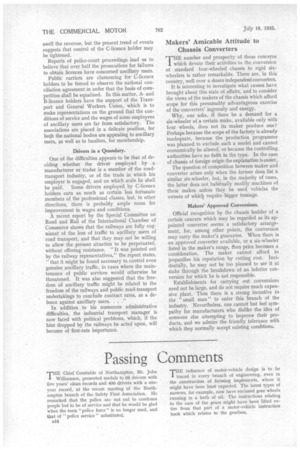Shadows Over Ancillary Users
Page 25

Page 26

If you've noticed an error in this article please click here to report it so we can fix it.
\y/HEN the Road and Rail Traffic Act, 1933, W was under consideration, it was generally expected that the ancillary user would be free from statutory interference, other than that neces sary to secure the observance of the few simple conditions attaching to C licences. Indeed, it was thought that the ancillary user .had been brought within the scope of the licensing system merely to swell the revenue, but the present trend of events suggests that control of the C-licence holder may be tightened.
Reports of police-court proceedings lead us to believe that over half the prosecutions for failures to obtain licences have concerned ancillary users.
Public carriers are clamouring for C-licence holders to be forced to observe the national conciliation agreement in order that the basis of competition shall be equalized. In this matter, Aand B-licence holders have the support of the Transport and General Workers Union, which is to make representations on the ground that the conditions of service and the wages of some employees of ancillary users are far from satisfactory. The associations are placed in a delicate position, for both the national bodies are appealing to ancillary users, as well as to hauliers, for membership.
Drivers in a Quandary.
One of the difficulties appears to be that of deciding whether the driver employed by a manufacturer or trader is a member of the roadtransport industry, or of the trade in which his employer is engaged, and on which scale he shall be paid. Some drivers employed by C-licence holders earn as much as certain less fortunate members of the professional classes, but, in other directions, there is probably ample room for improvement in wages and conditions.
A recent report by the Special. Committee on Road and Rail of the International Chamber of Commerce shows that the railways are fully cognizant of the loss of traffic to ancillary users of road transport, and that they may not be willing to allow the present situation to be perpetuated, without offering resistance. "It was pointed mit by the railway representatives," the report states, " that it might be found necessary to control even genuine .ancillary traffic, in cases where the maintenance of public services would otherwise be threatened. It was also suggested that the freedom of ancillary traffic might be related to the freedom of the railways and public road-transport undertakings to conclude contract rates, as a defence against ancillary users. . . ."
In addition to his numerous administrative difficulties, the industrial transport manager is now faced with political problems, which, if the hint dropped by the railways be acted upon, will become of first-rate importance.
Makers' Amicable Attitude to Chassis Converters
THE number and prosperity of those concerns which devote their activities to the conversion of standard four-wheeled chassis to rigid sixwheelers is rather remarkable. There are, in this country, well over a dozen independent converters.
It is interesting to investigate what causes have brought about this state of affairs, and to consider the views of the makers of the chassis which afford scope for this presumably advantageous exercise of the converters' ingenuity and energy.
Why, one asks, if there be a demand for a six-wheeler of a certain make, available only with four wheels, does not its maker produce one? Perhaps because the scope of the factory is already inadequate, because the production programme was planned to exclude such a model and cannot economically be altered, or because the controlling authorities have no faith in the type. In the case of chassis of foreign origin the explanation is easier, The question of competition between maker and converter arises only when the former does list a similar six-wheeler, but, in the majority of cases, the latter does not habitually modify machines of -these makes unless they be used vehicles the owners of which require bigger tonnage.
Makers' Approved Conversions.
Official recognition by the chassis builder of a certain concern which may be regarded as its appointed converter seems a satisfactory arrangement, for, among other points, the conversion may carry the maker's guarantee. When there is an approved converter available, or a six-wheeler listed in the maker's range, then price becomes a consideration. The maker cannot afford to jeopardize his reputation by cutting cost. Incidentally, he may not be too pleased to see it at stake through the breakdown of an inferior conversion for which he is not responsible.
Establishments for carrying out conversions need not be large, and do not require much expensive plant. Thus there is a strong incentive to the "small man" to enter this branch of the industry. Nevertheless, one cannot but feel sympathy for manufacturers who dislike the idea of someone else attempting to improve their products, and we admire the friendly tolerance with which they normally accept existing conditions.




















































































